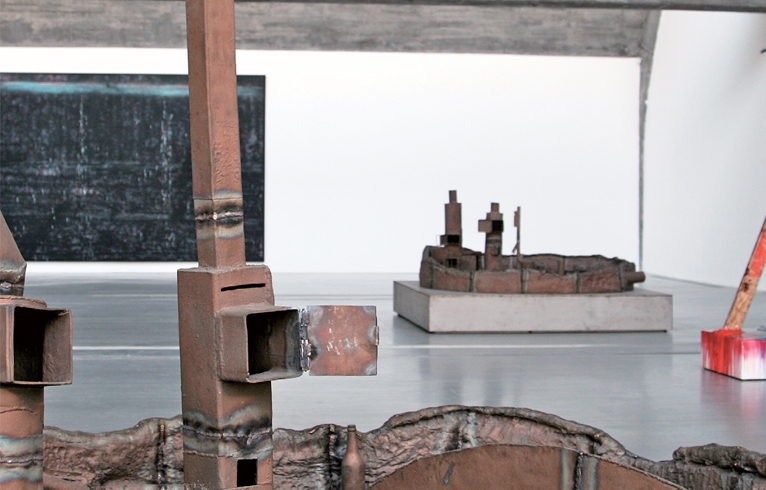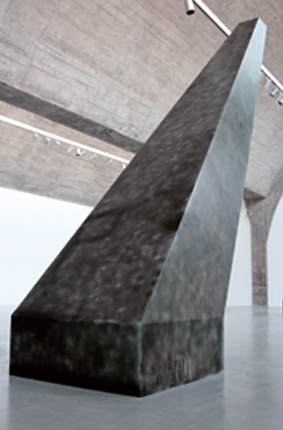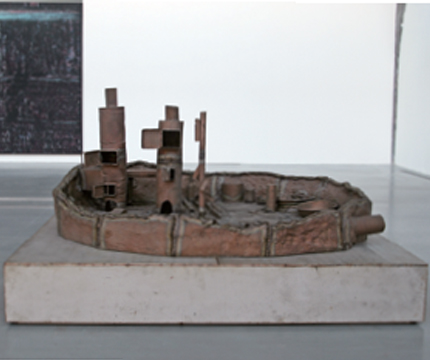STERLING RUBY: TRUNCATED MALLEABILITY
| November 30, 2011 | Post In LEAP 11

“VAMPIRE” MAY MARK the first time Pace Beijing has held a Western artist’s solo exhibition, but this is not Sterling Ruby’s first show in China, he having also made an appearance in UCCA’s 2008 group exhibition, “Stray Alchemists.” In that show, his piece, a nine-meter-tall monument, took up almost the entirety of UCCA’s central hall. The piece was named Recondite, appropriate given that it provoked precisely that reaction in Chinese audiences. For his latest showing in Beijing, Ruby has prepared an entirely new collection of works, among them his famous stone sculptures, spray-painted geometrical monuments meant to symbolize city government, fabric weavings, and basin-shaped sculptures made of porcelain and bronze. The exhibition features nearly all of the mediums in which the artist works, making the show a fitting introduction for anyone viewing Ruby’s work for the first time.
MATERIALS
Before he began studying art, Ruby spent time in both the agronomy and construction fields. As a result, he is comfortable working with industrial materials. In his works, he is excellent at mixing profoundly different materials, perhaps as a result of his time working as an assistant to the artist Mike Kelley: two years during which he both gained an understanding of the qualities of different materials and applied that understanding to practice. In his massive, minimalist sculptures, Ruby’s talent for scrawling sentimental “smudges” emerges. Their cold, rough exteriors have come to form his most undisguised visual vocabulary.
LEAP: In your sculptures, you command a variety of materials. How do you control and balance the different expression of different materials?

Sterling Ruby: I always feel like certain materials embody certain subjectivities, certain ideas. And if aesthetically it can convey that, then it doesn’t matter what the form is, what the scale is, what materials you use. I don’t think of myself as a materialist, but I still believe that there are certain materials that are better at conveying a certain message than others. Usually with bronze casting when you make a large sculpture it is made up of several pieces, and part of the finishing process is making sure you don’t see how the sculpture is chopped up, so the foundry will grind out the seams. When I made my first bronze I went to the foundry before it was finished and I liked that you could still see the stitching together of the parts, almost as if it were this Frankenstein re-animation. And I wanted to leave that. I wanted the aggression of the welds and the heat patina that formed on the piece to remain visible. I wanted it act as a reminder of how it was made.
METHOD
In the works for his “Monument Stalagmite” series, Ruby chose to work with forms laden with social and symbolic meaning. But the construction of his “monuments” has little in common with the themes of honor and remembrance usually associated with common memorials, superseded instead by the symbolic capacity of memorials: remnants of times gone by, histories never to be recovered. His are “truncated” objects. They have no way of recovering the meaning that they once had.
For years, Ruby has mulled over the theme of truncation. Through repetition, he has sought to refine a “truncated malleability,” personified in the underlying theory of “Monument Stalagmite.” The concept of “bloodties” runs through his work, unifying different forms and media. In “Monument Stalagmite,” truncation is not a form of nostalgia; rather, Ruby’s motif seems meant to evoke an instant just passed, offering a portal leading to a futureless present that is just about to arrive.
LEAP: Monuments seem to be a key concept in your work. What does this mean in terms of architectural discussion?

Sterling Ruby: I like to think of most of my artwork as monumental. That doesn’t necessarily mean grandiose or big or important. For me the monument acts as a marker for something that was lost to the past, that we keep trying to get access to, but have no possibility of obtaining. I started thinking about the monument very early on as a symbol of where my generation was in art history; my art school education was a French postmodernist theory-laden curriculum, and many of my peers were taught this way. The more I engaged with that way of thinking about artwork, the more it felt like a trap. We had been taught in such a way that we fought things like Abstract Expressionism or gesture, or mark-making. I started to think about the monument in terms of truncated malleability, as something that had at one time been very expressive but at this point had no possibility of having expression anymore. And that was sad, traumatic. That’s primarily where the idea of the monument came into play for me.
SOURCES
In Sterling Ruby’s “SUPERMAX” trilogy (2005, 2006, 2008), the prison system served as a metaphor for extremes within American culture. The system originates in an American concept: to abandon all attempts at reform, and settle for the controlling, imprisoning eyes of surveillance cameras. In his show last year at Pace Wildenstein in New York, “2Traps,” his works Bus and Pig Pen directly confronted contemporary issues such as these, setting ideas like the relationship between people and society, systemic oppression, and individual impulse in radical opposition to one another. The same is true of the SUPERMAX concept; Ruby maintains that detainment— isolating the individual away from the world at large— is itself stagnating, truncated, hinting at the idea behind “Monument Stalagmite.”
LEAP: “Evil” has different interpretations in Western and Eastern contexts. How does the “vampire” theme of this exhibition tie in with its setting in China?
Sterling Ruby: I wasn’t necessarily thinking of the vampire being representative of each and every work in the show but more as a way of expressing a kind of dialogue. First, I like the idea that the vampire has to be invited in in order to have access, that a vampire cannot cross a boundary unless invited. I really liked that idea in terms of exhibiting here in China. So in a sense it refers to the opportunity that I was given by Leng Lin and Pace Beijing to be the first Western artist to be given a solo show at the gallery. I was also thinking about the idea of the vampire as an allegory for consumption, which is very relevant to American culture and society, and perhaps also for China. So I guess I wasn’t really thinking about the concept of evil, and in terms of my own work, I try not to make moral judgements. I prefer to think of my work and its relationship to morality as schizophrenic. It has no stability. It has no judgement. It is always fragmented and always at unrest with itself.
Translated from Chinese / Translation: Matthew Schrader


